 |
11th CARL
Conference 2006
Beyond
the Ivory Tower:
Creative Strategies for Learning & Leading
April
20-23, 2006. Conference
News
|
|
|
 Poster Sessions
Poster Sessions
Tips for Presenters
Archive of Submission information
Poster Session Committee
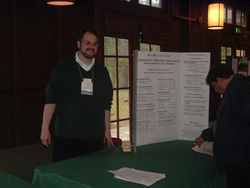 Are We Listening? The Presence of Design Flaws on University Library Web Sites
Are We Listening? The Presence of Design Flaws on University Library Web Sites
John Brandt Electronic Resources Librarian
California State University, Stanislaus
jbrandt@csustan.edu
Abstract: Research studies and experts have consistently recommended pitfalls to avoid when designing usable library Web sites. Content analysis of university library Web sites in 2003 and the same sites in 2006 indicates designers of library sites have adopted some but not all of the design recommendations found in the literature.
Academic libraries face increasing competition from commercial Web sites and other online resources such as Google Scholar. Designers of library Web sites must be diligent to maximize access to quality library resources while minimizing the hurdles students must overcome to reach these sources. Obstacles to site navigation due to poor design need to be minimized so libraries can maintain their place as the leading provider of high-quality research and information sources. A review of usability studies and Web design advice published in the library literature reveals several recommendations of practices to avoid when designing library Web sites. Excessive reliance on library jargon, inconsistent layout, and the lack of contextual information have all been cited by multiple researchers as elements which impede student use of Web pages. In 2003, the Web sites of sixteen mid-sized public universities were examined for the presence of twenty design characteristics, including vocabulary usage, link placement, contextual help, and site organization. Content analysis revealed many of these sites exhibited major design pitfalls highlighted in the library literature. For example, when describing the link to their OPAC, most made no mention of a word like "books" but relied on the term catalog, even though usability studies had consistently shown that term is meaningless to many students. Each of these Web sites was reexamined in 2006 for the same twenty design characteristics. Analysis of the current sites indicates that while there has been a marked decline in problematic features, some design pitfalls are still impeding the usability of, and ultimately students' success navigating, academic library Web sites. The poster session will highlight the improvement seen over the past three years, but also identify problems which are still present.
 H-ITT Me with Your Best Shot: Real-time Assessment Using a Classroom Response System
H-ITT Me with Your Best Shot: Real-time Assessment Using a Classroom Response System
Debbi Renfrow, Instruction Coordinator
University of California, Riverside
debbir@ucr.edu
Abstract: This poster session will introduce CARL attendees to the H-ITT classroom response system. This new technology is being widely used in academia. Librarians can apply this tool to library instruction, examining the role it can play in assessment. The poster will show actual responses from students.
From this poster session, attendees will learn about the classroom response system H-ITT, an emerging technological tool that can be applied in a library instruction setting. While teaching research skills, librarians struggle with the ambiguity of not knowing if students are truly ‘getting it.’ We give pre-tests and post-tests to find out what the students already know, what they have learned, and what was still confusing. Ideally, we then alter our instruction to teach confusing aspects better next time. But what about those students that have left the library still confused?
The classroom response system is a practical tool that allows for real-time, immediate assessment that indicates students’ level of understanding. It allows both the librarian and the students to graphically see what concepts are still problematic. Being witness to this increases the relevancy of the session to the students.
In addition to struggling with assessing the effectiveness of instruction, librarians are familiar with teaching non-participatory students. Even the most active learning activity can elicit minimal interaction amongst students. The H-ITT system increases student participation by soliciting anonymous feedback throughout a library instruction session.
This poster session will walk librarians through the process of evaluating various vendors, acquiring the system, installing it, and finally using it in a library instruction setting.
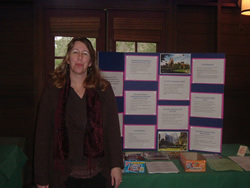 Information Literacy Assessment: What Works, What Doesn’t and the San Jose StateUniversity Library Experience
Information Literacy Assessment: What Works, What Doesn’t and the San Jose StateUniversity Library Experience
 Toby Leigh Matoush, Reference/Instruction Librarian
Toby Leigh Matoush, Reference/Instruction Librarian
San Jose State University
tmatoush@sjsu.edu
Abstract: This poster session will detail the San Jose State University experience using two national information literacy assessment tests currently being developed: the ETS Information and Communication Technology Literacy (ICT) Test and the Standardized Assessment of Information Literacy Skills (SAILS) Test.
Former Library Dean and information literacy expert Patricia Breivik left a rich legacy of information literacy programs at San Jose State University (SJSU) before her retirement in May 2005. Information literacy has been infused into the SJSU curriculum at many levels including the freshman level, and was recently written into the University GE Guidelines. In order to test the efficacy of information literacy instruction, standardized and reliable assessment must be set up at the university level. SJSU has been involved from the start with the beta-testing of two national information literacy test instruments currently being developed: the Standardized Assessment of Information Literacy Skills (SAILS) program, and the ETS Information and Communication Technology (ICT) Literacy Test. As SJSU coordinator for these programs, I have directed the administration of both tests at SJSU. Both of these information literacy assessment surveys show enormous promise as standardized, valid, and reliable instruments to be used in university-wide assessment of information literacy and technology skills. Although both instruments test information literacy based on the ACRL Information Literacy Competency Standards for Higher Education, they have many important differences. This poster session will detail the advantages and disadvantages of each instrument and serve as a blueprint for university libraries interested in future information literacy assessment. The increased climate of accountability and need for standardized and reliable assessment instruments at universities nationally makes debate on information literacy assessment methodology extremely valuable and timely. The lessons learned from the San Jose State University assessment experience can serve as an important tool in guiding other academic libraries interested in information literacy assessment.
 Inside or Out: Can Blogs Solve Any of Our Communication Problems?
Inside or Out: Can Blogs Solve Any of Our Communication Problems?
 Erin Bower, Instruction Librarian
Erin Bower, Instruction Librarian
Sonoma State University
erin.bower@sonoma.edu
Abstract: History has yielded an impressive array of technologies that have improved communication. However, in those perennial communication situations where the otherwise successful phone call, email, IM, walkie talkie chit chat, meeting, flyer or smoke signal has failed us, are blogs a promising solution? At Sonoma State University Library, a recent web site redesign provided an opportunity to explore blogs as a technology to improve internal and external communication.
With four new blogs: Snoopings, ermblog, Technical Twists, and At the Library, we are attempting to solve four unique communication needs. Snoopings is a current awareness blog to which staff can post new and exciting developments in the information world. Ermblog, an internal blog, was created to track the implementation of the ERM (Electronic Resource Management) technology, a project which involves lots of information sharing. Technical Twists is a place for staff to communicate about day-to-day issues that affect public services immediately, such as database problems or printing issues. At the Library is our external marketing blog which feeds onto the homepage of the library.
While sketching out issues of implementation, use and assessment, this poster will examine which of these four blogs have been successful at improving our communication and why, as well as what questions remain unanswered.
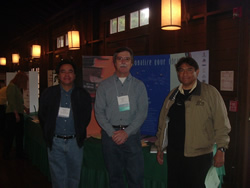 Internationalize Your Library - Mexico and California Library Connections
Internationalize Your Library - Mexico and California Library Connections
Patrick Sullivan, Business Librarian, San Diego State University
Profesor Raúl Rodríguez G., Director de Centro de Información
Biblioteca CETYS Universidad, Tijuana, BC
Lic. José Armando Robles Reyes, Director de Biblioteca
Biblioteca CETYS Universidad, Mexicali, BC
sullivan@mail.sdsu.edu; rraul@tij.cetys.mx ; armando@cetys.mx
Abstract: While California and México share a long border and an even longer history, librarians on both sides have not worked as closely as we would prefer. Recently, through Sister Library relationships, establishment of the Baja California Librarians Association (ABIBAC) and assorted border activities the presenters have raised the level of dialog across the border and would like to share their experiences with other interested attendees.
Since 1999 when CETYS University in Mexicali hosted the 9th Transnational Library Forum, the Baja California librarians have been working to strengthen the communication between Mexican and California librarians. Recently they have established a library association, ABIBAC, which provides a forum similar to CARL for the Baja California library community. This poster session explores a number of efforts in the border region, from Fulbright scholarship experiences and Sister Library relationships to how our colleagues south of the border are more effectively integrating themselves into the international library community. Come and learn about opportunities to pursue Sister Library relationships with Mexican academic libraries (or other countries) and become more aware of the current state of affairs with Mexican librarians.
Patrick Sullivan, from San Diego State University, is currently working on a Fulbright Garcia-Robles Border Scholarship and has worked closely with the CETYS University system with campuses in Mexicali , Tijuana and Ensenada. We will provide insight into the "Fulbright process" and what is entailed for librarians who are applying for these scholarships.
The CETYS Library Directors of the Mexicali and Tijuana campuses respectively, Armando Robles and Raúl Rodriguez, will share with conference goers their observations of libraries from their unique cross-border perspective. They will discuss with CARL librarians their successes and challenges in creating a new library association. They'll also be soliciting ideas for incorporation into this new library group south of the border. If you are interested in how library associations and libraries in México function, make sure to stop by and visit with the US/Mexico team of librarians.
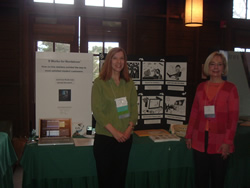 It Works for Nordstrom: How Online Retailers Pointed the Way to More Satisfied Student Customers (& How iPods Help Spread the Word)
It Works for Nordstrom: How Online Retailers Pointed the Way to More Satisfied Student Customers (& How iPods Help Spread the Word)
 Vicki Rosen, Head of Distance Learning Services and Regional Libraries
Vicki Rosen, Head of Distance Learning Services and Regional Libraries
Eric Shappy, Distance Learning Services Operations Coordinator
Pam Chesney, South Bay Regional Librarian
Kathleen Restaino, South Bay Regional Library Assistant
University of San Francisco
rosen@usfca.edu ; shappy@usfca.edu ; chesney@usfca.edu ; ksrestaino@usfca.edu
Abstract: This poster session shows how we turned a persistent library customer complaint into an innovative customer service. Using online retailers Nordstrom and Amazon as models, we incorporated a new USPS (U.S. Postal Service) Merchandise Return Service into our document delivery offerings. This e-service provides on-line, prepaid label generation for return mailing of books and packages from students and faculty affiliated with our regional campuses. The library pays all costs and students can mail their packages from any USPS pick-up.
The detailed process of making it work included: applying for and purchasing official US postage permits, setting up a postal deposit account, purchasing hardware, downloading web tools and programming code, and working with our Information Technology department to integrate the service into our website. By fall 2005, we were ready to launch the service. We began with both oral and written promotion of the return service and are now developing video/pod casts. The service is proving a great success, receiving praise from students, faculty, librarians, and university administrators. We’re excited to be the first library to our knowledge to offer this creative solution and improve library customer service satisfaction for distance learners.
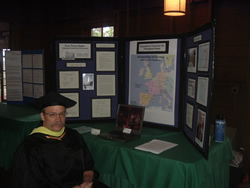 Ivory Tower Origins — Libraries in the First Universities
Ivory Tower Origins — Libraries in the First Universities
 Ned Fielden, Reference/Instruction Librarian
Ned Fielden, Reference/Instruction Librarian
San Francisco State University
fielden@sfsu.edu
Abstract: A look at early university libraries, reminding us as librarians of our beginnings and original mission, may prove instructive when considering contemporary academic libraries. An examination of library growth from the 12th-15th centuries, the evolution of scholarship, and subsequent technological innovations, permits insight into the development of modern research-oriented academic libraries.
Before considering any movement outside the ivory towers of academia, it may be useful to consider university origins and primary mission. The twelfth century saw the rise of the first universities in the western tradition, at Paris, Oxford and Bologna, and later among other European cities. The universities quickly became the main avenue for training clerics and the ruling elite of various states. Many of these university traditions are handed down to the present, where a university education remains an essential component of intellectual and professional life. The library collections for these first universities were vestigial affairs, and it was not until the mid 14th century that buildings were erected with the specific purpose of holding library collections. What were these first university libraries like? How were books handled by early masters and scholars? How were books managed and what role did librarians have in the early days of the university? Examining the extensive secondary literature and the extant library catalogs and regulations of the medieval universities provides some sense of the archaic foundations of our profession. This poster session, part of ongoing research into university library history, will explore these questions and address the growth of university collections over several centuries. Photos and plans of early college and university libraries, the schema for the placement and organization of books, and various data surrounding librarian practices help illuminate early university library life. Reflecting on the use of libraries in the first universities may provide some insight into, and a rethinking of, contemporary academic library operation and function.
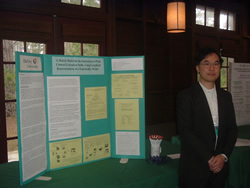 A Mental Model for the Instruction of Web Content Evaluation Skills, Using Graphical Representations of a Stakeholder Model
A Mental Model for the Instruction of Web Content Evaluation Skills, Using Graphical Representations of a Stakeholder Model
 Jordan Yee, Library Director
Jordan Yee, Library Director
DeVry University Northern California
jyee@fre.devry.edu
Abstract: Multiple graphical representations of elements of a stakeholder model for evaluating web content are presented. These elements are: the Information Use Pyramid, Web Content Continuum, Web Site Index Creation Dynamics, Licensed Content - an Analogue to the Library Collection, and the Information Stakeholder model.
The Internet, by some accounts, has resulted in the degradation i n the quality of student research. A recent Consumer Reports WebWatch survey, found that 46.1% of Internet users mainly relied on superficial visual cues, such as a page’s design, to gauge a site's credibility. College students are no exception. The over-reliance on Internet search engines by students in effect, by-passes the quality control that librarians have traditionally exerted over content found in libraries and used by students. Students, having little awareness of their lack of evaluation skills and their limited understanding of the Internet as a resource, are satisfied with their presumed “skills” in using the Internet.
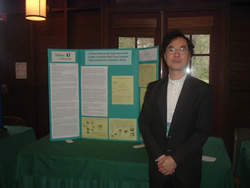 Web evaluation is often taught as checklists of discrete evaluation criterion -- terminal questions soliciting a simple “yes” or “no”. For example: Are there dates on the page to indicate when the page was written? Or, is it clear what organization is responsible for the contents of the page? The weight of multiple affirmative or negative responses leads towards a determination of a webpage’s quality. While checklists are an aid to webpage evaluation, their mechanistic nature, can lead to the rejection of websites from authoritative sites such as the World Health Organization, because the content is presented under the implied authorship of the corporate author and thus lacks attribution. At the same time, content from highly questionable sites (www.martinlutherking.com) when evaluated against such criteria is found to have a publication date, and a clear identification of both a personal author and the publishing (sponsoring) organization. It is no surprise then that studies have found “a checklist alone was insufficient to help students evaluate Web sites.”
Web evaluation is often taught as checklists of discrete evaluation criterion -- terminal questions soliciting a simple “yes” or “no”. For example: Are there dates on the page to indicate when the page was written? Or, is it clear what organization is responsible for the contents of the page? The weight of multiple affirmative or negative responses leads towards a determination of a webpage’s quality. While checklists are an aid to webpage evaluation, their mechanistic nature, can lead to the rejection of websites from authoritative sites such as the World Health Organization, because the content is presented under the implied authorship of the corporate author and thus lacks attribution. At the same time, content from highly questionable sites (www.martinlutherking.com) when evaluated against such criteria is found to have a publication date, and a clear identification of both a personal author and the publishing (sponsoring) organization. It is no surprise then that studies have found “a checklist alone was insufficient to help students evaluate Web sites.”
This paper/poster proposes as a complement to evaluation checklists, instruction in a complete mental model of the web as an information retrieval system and “content repository.” A mental mode according to Johnson-Laird is a “psychologic representation that aids in understanding, explaining, or predicting how a system works.” Mental models are a tool for higher order cognitive processes and they can positively influence a user’s performance due to the structure they can impose. Structural knowledge is vital to performance at an expert level. When interacting with complex systems such as the Internet, users will form a mental model of the system, inaccurate though it may be, based on their experiences. Instruction in an accurate model can supplant a user’s inaccurate model. The Stakeholder model provides a conceptual framework for evaluating web content and it is a robust complement to discrete checklist criteria. This model shows promise and it sets the foundation for the presentation a more complex industry model at a later stage.
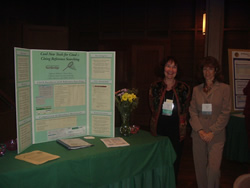 New Tools for Cited and Citing Reference Searching
New Tools for Cited and Citing Reference Searching
Stephanie Ballard, Reference and Instruction Librarian
Marcia Henry, Reference and Instruction Librarian and Database Coordinator
California State University Northridge
stephanie.ballard@csun.edu ; marcia.henry@csun.edu
Abstract: The twin goals of promoting alternative ways to find cited and citing references are: 1) to address the high cost of the traditional ISI citation indexes, and 2) to achieve more comprehensive searches by partnering these indexes with a federated search engine and free Internet cited/citing reference features. This poster provides practical and effective strategies for using these exciting new tools.
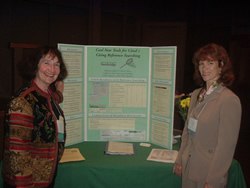 This poster covers the history of cited/citing reference searching from Eugene Garfield's groundbreaking ISI databases (Science Citation Index and Social Science Citation Index) to the currently-available features in subject-specific databases (such as PsycINFO and CINAHL) and free on the Internet (GoogleScholar). It shows how one university/college has addressed the high cost of ISI databases by using new information tools in partnership with traditional ISI databases. This strategy not only yields savings in subscription costs, but it also identifies additional citations which are not indexed in the ISI databases.
This poster covers the history of cited/citing reference searching from Eugene Garfield's groundbreaking ISI databases (Science Citation Index and Social Science Citation Index) to the currently-available features in subject-specific databases (such as PsycINFO and CINAHL) and free on the Internet (GoogleScholar). It shows how one university/college has addressed the high cost of ISI databases by using new information tools in partnership with traditional ISI databases. This strategy not only yields savings in subscription costs, but it also identifies additional citations which are not indexed in the ISI databases.
Acquiring effective skills for searching cited and citing references is of perennial interest to scholars, faculty members, students. Sharing these skills with our non-librarian colleagues is a prime example of “reaching beyond the library . . . to engage in meaningful dialogue with those in other academic disciplines and the academy at large”, as stated in the theme for this conference. This poster provides details about using CSU-Northridge’s DIALOG ISI custom web search forms, proxy technology which identifies authorized patrons, and the latest subscription database features and Internet search engines to extend on limited retrievals and provide more comprehensive searches. Attendees will receive a bibliography of relevant articles and websites of cited/citing reference searching tutorials.
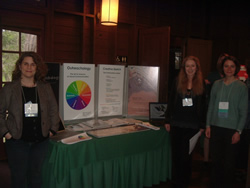 Outreachology: The Art and Science of Visual Communication Resources
Outreachology: The Art and Science of Visual Communication Resources
 Bernadette Swanson, Instruction/Reference Librarian
Bernadette Swanson, Instruction/Reference Librarian
Sheila Cunningham, Instruction/Reference Librarian
Melissa Browne, Instruction/Reference Librarian
UC Davis
bmswanson@ucdavis.edu ; scunningham@ucdavis.edu ; mabrowne@ucdavis.edu
Abstract: Library Instruction Services is a new department with four full-time instruction librarians, two staff members and two part-time student assistants with graphics expertise. It is our responsibility to provide library outreach to a campus population of approximately 30,000 students. We recently launched a multi-pronged visual media campaign to bring our core message (help desks, workshops, answers) to students in their environment. This poster session showcases our collaborative approach to outreach on a minimal budget, and includes examples from our portfolio.
In Fall 2004, Library Instruction Services developed content for two posters that appeared on 39 community buses frequented by UC Davis students. The project included personnel from three separate library departments and support from the library administration. Our continued foray into visual media outreach involves time and budgetary constraints and technical hurdles. Over the past year and a half, the department has systematized its approach as the library outreach campaign has expanded to include billboards, motion video ads and mini movies, instruction posters and handouts.
The department uses Macromedia's Captivate for its motion video ads and mini movies, and Adobe Creative Suite 2 (Photoshop, Illustrator, InDesign) for billboards, signs and posters. It purchases photos from iStockPhoto, www.istockphoto.com , a fee-based web resource. The department has access to a color plotter as well as a color laser printer.
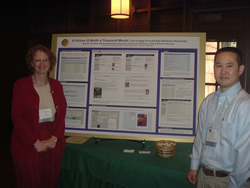 A Picture IS Worth a Thousand Words: How Images Promote New Electronic Resources
A Picture IS Worth a Thousand Words: How Images Promote New Electronic Resources
 Michael Yonezawa, Reference/Electronic Resources Librarian
Michael Yonezawa, Reference/Electronic Resources Librarian
Vicki Bloom, Head of Reference Services
University of California , Riverside
Michael.yonezawa@ucr.edu ; Vicki.bloom@ucr.edu
Abstract: Using visually appealing thumbnail images, electronic resources werespotlighted every 2-3 weeks under a specially created “Featured Resources” section on the front page of UC Riverside Libraries web site. Examples, image and page development, use statistics, and future enhancements will be shown.
Promoting new electronic resources is a critical component of information literacy, awareness, and acceptance by an academic user community. At UC Riverside Libraries we needed a way to alert and hook users to relevant research material without inundating the campus mail system. By harnessing the visual and dynamic technologies of the Internet, we were able to successfully entice users to learn about interesting and newly acquired online sources, changes in vendors and content, relevant workshops that utilized particular resources or databases that tied into current world events.
Attractive thumbnail images were prominently displayed on the front page of the web site under a section designated, “Featured Resources.” The accompanying links led users to pithy articles that succinctly explained why the resources were useful.
The UCR Libraries Website’s Content Management System allows for the development and management of our Featured Resources database. Entries can be created for individual resources by any subject specialist in draft form, edited, and finally approved for automatic posting for a specified range of dates. The ability to create entries in advance allows librarians to “can” several features ahead of time and to plan promotional tie-in around related events. Since the entries are saved in a database they can be recycled or updated as needed. The Content Management System also tracts use statistics. We know that our image-based Featured Resources section is immensely popular – in fact, last year this section was clicked on 52,401 times!
The current Featured Resources are created in XML – Extensible Markup Language and allow for RSS Readers – (Really Simple Syndication) to dynamically post the entries. Future enhancements include a subscription based e-mail alerts service which will provide yet another avenue to promote the latest resources added to our collection.
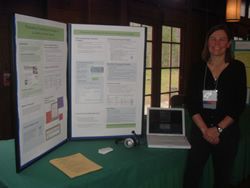 Podcasting: Extending the Reach of a Library Lecture Series
Podcasting: Extending the Reach of a Library Lecture Series
 Ann Hubble, Electronic Information Resources Librarian
Ann Hubble, Electronic Information Resources Librarian
University of California , Santa Cruz
ahubble@ucsc.edu
Abstract: This poster will describe the process of creating a podcast for a quarterly lecture series sponsored by the UC Santa Cruz Science & Engineering Library.
The existence of a newly created lecture series at the Science & Engineering Library (S&E Library), highlighting UC Santa Cruz faculty research presented a unique opportunity to experiment with creating podcasts and thus learn more about a new technology - from creating and publishing podcasts, to helping users access them.
In April 2004, the S&E Library began offering a new quarterly lecture series held within the library. A web page was initially created to support and promote the lecture series, and by the second faculty lecture, streaming audio files were added to the site. From that time on, users could download and listen to individual lectures via a desktop computer. In December 2005, podcasts were offered as an additional delivery method for the lecture series. The podcast feeds were created fairly easily with the addition and customization of a free plug-in added to blogging software (Moveable Type) the library was already using.
This poster will describe the tools and methods used to create podcasts, as well as general experiences, such as publicizing and supporting podcasts. It will also examine what effect adding an additional delivery method has made to the lecture series, and the Library.
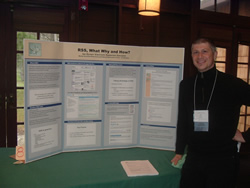 RSS: What, Why, and How
RSS: What, Why, and How
 Ilan Eyman, Electronic Outreach Librarian
Ilan Eyman, Electronic Outreach Librarian
University of California , Berkeley
ieyman@library.berkeley.edu
Abstract: Introducing RSS feeds to researchers. A brief history of the technology, a comparison with other current awareness methods, and ways to discover RSS feeds will be presented.
RSS Feeds are the latest and best way to cope with difficulties of keeping up-to-date. It allows a researcher to combine information from blogs, tables of contents, and SDI searches in one convenient web page.
RSS technology was developed 10 years ago but has just recently taken off in popularity. The New York Times has been offering RSS feeds for “All the news that’s fit to print”, and tables of contents of many prestigious journals are all now being delivered via RSS feeds. Last year, PubMed and SilverPlatter began offering RSS feeds and early this year we expect to see RSS feeds from ISI’s Web of Knowledge interface.
So it's time to look at what this technology has to offer researchers. Specifically, how can RSS enhance or supplant other methods of SDI? This poster session will cover a brief history of the technology and will compare it with e-mail and web surfing. The future of these three technologies for research will also be addressed. Handouts of strategies to discover and collect RSS feeds, and critical next steps that we as librarians need to take in promoting this technology for our researchers will be available.
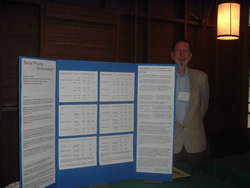 Serial Pricing ... Gone Astray?
Serial Pricing ... Gone Astray?
 Dana L. Roth, Science Reference/Chemistry Librarian
Dana L. Roth, Science Reference/Chemistry Librarian
California Institute of Technology
dzrlib@library.caltech.edu
Abstract: A comparison of serial pricing between commercial and non-commercial/society publishers suggests that there is little relationship between price/use and physical content. Data will be presented that compares price/page and price/page/impact factor for a representative sample of science journals. These data should be very useful in serial cancellation decisions.
Journal subscription price comparisons often have very little resonance with faculty members, especially when their favorite titles are at or near the top of the most expensive list. Cost/page and cost/page/Impact Factor data, when presented in conjunction with locally produced cost/use data, can form the basis for objective subscription evaluations.
Comparative data for 2000 and 2004 will be displayed for both journal subscription price increases, and cost/page & cost/page/impact factor. In addition, normalization of the cost/page/impact factor results provides a very useful 'cost effectiveness' measure, which can be also be used to estimate equivalent non-commercial subscription prices for commercially published journals.
Education of faculty and library administrators to the enormous disparity between pricing/use and physical content is essential for making rational serial cancellation decisions.
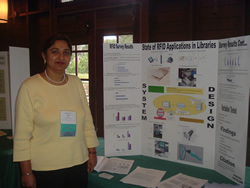 State of RFID Applications in Libraries
State of RFID Applications in Libraries
Navjit Brar, Assistant Dean, Access & Bibliographic Services
Jagjit Singh, Assistant Professor, Industrial Technology, School of Business
California Polytechnic State University
nbrar@calpoly.edu ; jasingh@calpoly.edu
Abstract: The adoption of Radio Frequency Identification (RFID) technology by libraries promises a solution that could make inventorying of items in their collection possible in days instead of months and allow patrons to check out and return library property automatically at any time of the day.
With an estimated 35 million library items tagged worldwide in over 300 libraries, this technology is generating an ever increasing interest. Besides speeding up checkouts, keeping collections in better order and alleviating repetitive strain injuries among librarians, RFID promises to provide a better control on theft, non-returns and misfiling of a library’s assets.
From October to November, 2004, the Industrial Technology Department and Robert E. Kennedy Library at Cal Poly State University , San Luis Obispo , surveyed participating libraries, RFID listserv, and LITA-L listserv subscribers to collect information with regards to the implementation of RFID systems in libraries. As a result of the positive response from library world, vendors interest in loaning us with this technology for testing, and our own students interest that would prepare them for a better job market, we decided to further conduct research by actually testing this system. Libramation provided us with the equipment for testing during spring 2005. With the RFID simulation of 250 items, this project addressed common issues of contention for any library. The hypotheses tested were that the system will simplify the check in and checkout process for staff, increase efficiency, and minimize repetitive motion; provide a self-check component; be able to secure magnetic media such as videos and cassettes, and be able to handle the discharge function in a manner similar to books; provide a link between security and the bibliographic record; provide an efficient way to inventory the library’s collection without having to physically handle each item; provide a flexible system that could be used easily with new and future technology, such as an automated materials handling system; and combining RFID technology at the circulation desk, self-check machines, and eventually an automated materials sorting system, will free circulation staff to perform direct patron information services.
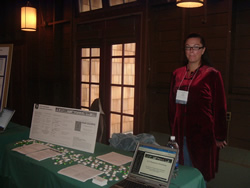 State of Union Address for Online Instruction: A Survey of the Latest Technologies Available
State of Union Address for Online Instruction: A Survey of the Latest Technologies Available
 Avril Cunningham, Instruction Coordinator
Avril Cunningham, Instruction Coordinator
California State Polytechnic University
acunningham@csupomona.edu
Abstract: This poster session will update you on the latest high tech tools available for your own library's online instruction needs. You will walk away with comparison handouts detailing the pros and cons, as well as low and high cost options for screen casting, dubbing voice & annotation software, simulation software, and advanced online PowerPoint presentations.
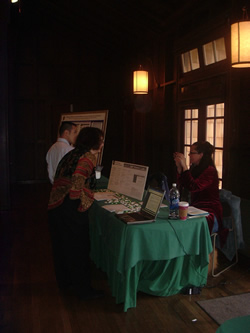 In the Fall of 2005, Cal Poly Pomona's in-person 90 minute EZ Research Workshop had reached its scheduling capacity. The program granted certificates of information competency to 200 students a quarter, and over 600 a year. Despite the success of the program, with our current instruction load and available classroom space, we could not offer more in-person classes. It was time to move it online, but we wanted to retain as much of the in-person pedagogical advantages as we could. After investigating the latest selection of software and plug-ins available, we were able to quickly mount an online version of the popular EZ Research workshop complete with audio, screen casting, images, and an assessment quiz with an automated online certification. The online certificate was crucial in ensuring the success of the tutorial. The certificates verify students attended and learned how to do basic library research during the online instruction and are presented to faculty members who require students attend the sessions. Without the certificate students would not be motivated to attend because they would not receive credit.
In the Fall of 2005, Cal Poly Pomona's in-person 90 minute EZ Research Workshop had reached its scheduling capacity. The program granted certificates of information competency to 200 students a quarter, and over 600 a year. Despite the success of the program, with our current instruction load and available classroom space, we could not offer more in-person classes. It was time to move it online, but we wanted to retain as much of the in-person pedagogical advantages as we could. After investigating the latest selection of software and plug-ins available, we were able to quickly mount an online version of the popular EZ Research workshop complete with audio, screen casting, images, and an assessment quiz with an automated online certification. The online certificate was crucial in ensuring the success of the tutorial. The certificates verify students attended and learned how to do basic library research during the online instruction and are presented to faculty members who require students attend the sessions. Without the certificate students would not be motivated to attend because they would not receive credit.
During our research phase, we gathered the latest information about high tech tools available. The poster session will include comparison handouts for screen casting, voice dubbing and narration, simulation software, and advanced PowerPoint instruction as well as information about the EZ Research workshop tutorial itself.
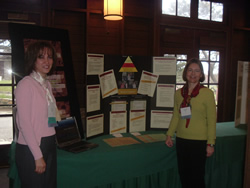 Tiered Reference Project: Library Staff Members and Professional Librarians in Pursuit of Excellence
Tiered Reference Project: Library Staff Members and Professional Librarians in Pursuit of Excellence
 Shahla Bahavar, Assistant Reference Coordinator, Information Services Division
Shahla Bahavar, Assistant Reference Coordinator, Information Services Division
Sophie Lesinska, Reference/Instruction Librarian - Arts & Humanities Team
University of Southern California
bahavar@usc.edu and lesinska@usc.edu
Abstract: At the University of Southern California library, staff members and professional librarians work together to improve the quality of reference services in our library system. This collaboration has produced not only an innovative reference training program, but also a cordial professional relationship between staff members and librarians, a necessary part of a good referral mechanism in any library.
At the University of Southern California library staff members and student employees answer questions in over 15 libraries on campus. Their training varies depending on their home library. To ensure uniformity in the quality of information services at all public service points, our reference coordinators launched the Tiered Reference (TR) project last year. The fundamental concept of this project is the tiered service model where basic questions are answered by student workers, more challenging ones are directed to staff and/or generalist librarians, and specialized queries are referred to subject experts.
The primary objectives of the TR project are: 1) to institute an effective referral system, and 2) to create an ongoing training program. In addition, the TR project fosters a positive collaboration between staff and librarians, and offers opportunities to experiment with various pedagogical approaches.
The TR project envisions four training modules, each tailored for a different audience. Module One gives managers tools to introduce students to the basics of information and reference services. Module Two focuses on the reference interview. Module Three will introduce the most popular online resources. Finally, Module Four will mobilize specialists to share their expertise. Referral surfaces as a theme in all four modules.
So far numerous staff members and students have attended our training sessions for Modules One and Two. Module One has been converted into a series of online tutorials that students can work on independently. Module Two features a short movie on the reference interview and effective customer service behavior.
The TR project is a work in progress. Not only does it help us improve our reference services; it also generates productive questions. Our current challenges include creating reliable online quizzes, finding better tutorial software, integrating virtual reference into our referral structure, and weighing the advantages and disadvantages of online tutorials. As a team, we are working together to find solutions to these specific problems. We are also looking forward to confronting future challenges and to building more seamless information services for our patrons.
Using Knowledge Discovery Method to Learn about Users’ Information Search Patterns and their Needs CANCELLED
Wei Ma, Electronic Resources Management & Reference Librarian
Todd Boostrom, Technology Coordinator
California State University , Dominguez Hills
wma@csudh.edu ; tboostrom@csudh.edu
Abstract: With the development of information technology and explosion of information resources, improving and enhancing library services to simplified information access process and to help attract more users has become one of the library’s priorities. To do this, we must understand how users use the library, how they access the information resources, what their needs are, and most important of all, be able to respond rapidly to their changing needs and usage patterns.
This research focuses on developing a methodology to regularly and automatically monitor detailed users’ information search patterns, detect user needs, etc. Our preliminary research results show that we could do this via analyzing detailed user access queries, such as which search categories they chose to start the search, what search terms they entered to search, whether they got search results, via what computers/networks, what operating systems they used, what browsers, computer IPs, date and times, how many times they repeated/re-entered the searching terms, etc. This presentation includes the capture technology used, types of data retrieved, data extraction methods, examples of data interpretation/applications, and our future research plans.
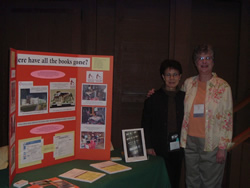 Where Have All the Books Gone?
Where Have All the Books Gone?
Paula J. Popma, Head, Acquisitions and Cataloguing
California State University , Fresno
Taeock Kim, Associate University Librarian
Santa Clara University
ppopma@csufresno.edu ; tkim@scu.edu
Abstract: Two libraries face the same challenge – what to do with all of their books while their new library buildings are constructed. This poster session will illustrate their individual solutions.
Santa Clara University (SCU), University Library, and California State University Fresno (CSUF), Madden Library face the same challenge. Both libraries will be demolished and new library buildings are scheduled to be built on the same sites as the old libraries. SCU Library contains 750,000 volumes and Madden Library contains 1,000,000 volumes. What will be done with all of the books while the new buildings are under construction? Both libraries analyzed the problem and reached different solutions. SCU built an Automated Retrieval System (ARS) to house the entire library collection and CSUF rented an off-campus warehouse to store all monographs and bound journals.
Both of these options required integrating a request feature into the libraries’ OPACs, so that end users could request volumes. Volumes are retrieved and delivered either the same day or the next day. A library doesn’t have to be in the process of constructing a new building to find this poster session useful. Many libraries are running out of space in their current facilities and need to explore space alternatives. This poster session will illustrate the challenges each library faced, the procedures developed, and the lessons learned. Photographs will show the interior of the ARS and warehouse and the process of moving thousands of books. OPAC screen shots will illustrate how the request feature appears and the process for placing a request. A one-page handout will be provided that highlights statistical data.
Poster Session Committee
Kristin Johnson, Chair. CSU, Chico
Lisa Bartle, committee member. CSU, San Bernardino
Amy Andres, committee member. CSU, Stanislaus
Feel free to contact Kris with any questions. 530-898-5686 or kajohnson@csuchico.edu
|
CARL is
an independent chapter of the Association of College and Research
Libraries. The information on this web site is wholly the responsibility
of CARL and implies no endorsement by ACRL
National. |
|

 Poster Sessions
Poster Sessions




















